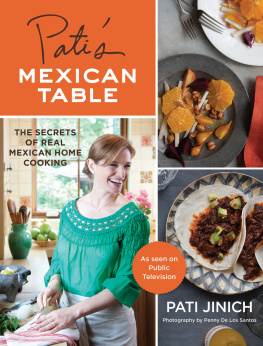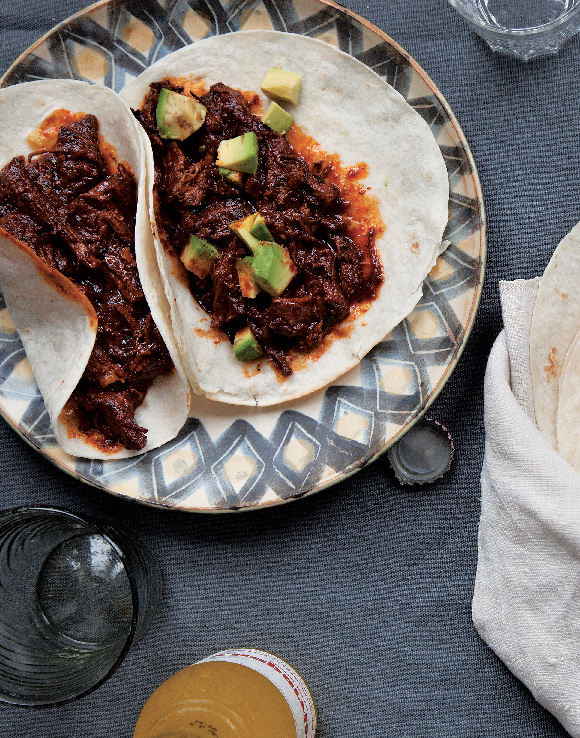Contents
Copyright 2013 by Patricia Jinich
Photographs copyright 2013 by Penny De Los Santos
All rights reserved
For information about permission to reproduce selections from this book, write to Permissions, Houghton Mifflin Harcourt Publishing Company, 215 Park Avenue South, New York, New York 10003.
www.hmhbooks.com
Library of Congress Cataloging-in-Publication Data is available.
ISBN 978-0-547-63647-4 (hardcover)
Food styling by Christine Albano
eISBN 978-0-547-63646-7
v1.0313
Show up in my kitchen any day of the year, and youll find soft corn tortillas, refried beans, at least two different salsas, the fresh Mexican cheese called queso fresco, ripe avocados, and fresh fruitessential ingredients for countless spur-of-the-moment meals. You are always welcome to join me, because I always cook more than we can manage to eat at one sittingnot out of carelessness, but because that is the practical way of Mexican kitchens.
Salsas are the maracas of my kitchen: They shake things up whenever I need an extra kick of flavor. They can be the base of a dish or the final stroke of genius, a condiment with mucho potencial : not always hot, but often fruity, salty, tangy, vinegary, or crunchy. Avocados are almost equally versatile. They can be pounded into chunky guacamole, of course, but also whizzed into a silky soup; tucked into thick, crusty rolls with potatoes and chorizo for a hearty torta , a Mexican sandwich; or buzzed together with milk, cream, and lime juice for an incomparably creamy salad dressing. Soft, mild, and teasingly salty, queso fresco can be sliced into sticks, or diced, or crumbled on top of soups, salads, tostadas, tacos, and enchiladas. The beans are waiting to be slathered on a roll when my voracious boys come home from school or play. And as for tortillas, they are the building blocks for so many dishes from breakfast to dinner every day of the week: wrapped around eggs, enfolding steak for tacos, holding together a casserole. Crisp them, and they become the sturdy base for ceviche tostadas or perfect scoops for salsas. Cut them smaller, and they are a crisp garnish for soups. And with fruits of all kindswatermelon, mango, pineapple, and moreI make some of the most refreshing drinks ever, with and without alcohol.
Im not sure that many Americans really understand Mexican home cooking. For me, its the everyday food I feed my family: the dishes I hanker for, the ones that make me feel at home and that, ironically, I mostly learned how to make while living away from the country where I grew up eating them. That food isnt taco salads, nachos slathered with cheese, or overstuffed burritos. Nor, for the most part, is it the complex mole sauces that take days to prepare. There are, however, other traditional dishes that I serve over and over again, because they are fabulous, as well as new dishes with creative spins that keep Mexican cooking evolving.
Mexican home cooking is beautiful in its simplicity, tremendously convenient, and wholesome. Out of our kitchens come some of the tastiest salads, soups, and cookies that you will ever find. Our food also includes a boatload of vegetarian options: casseroles of black beans and tortillas in chile sauce, plantain quesadillas stuffed with refried beans, eggs poached in delicious salsas. Not every dish has chile in it, nor is a dish necessarily spicy when it does. The best part is that this cooking fits our American lifestyle like a glove.
I didnt set out to be an obsessed food professional, but Im a Jewish-Mexican mother, so the obsessive part comes naturally. Originally I trained as an academic and got a job in Washington, D.C., at a policy think tank, where I focused on Mexican politics and history. Eventually, though, I listened to my husband, who kept asking why I persisted in working there when all I talked about were the foods of Mexico, and all I did in my spare time was cook.
It wasnt an easy decision to switch careers. I can still hear my dads jokes about how I wasted so many years: quemndome las pestaas como rata de biblioteca , which, loosely translated, means burning the midnight oil as a bookworm or, more literally, burning my eyelashes as a library mouse. Yet I have no regrets. Those were not wasted yearsthey gave me great research skills and a deeper understanding of Mexico.
Today Im a chef, food writer, and cooking teacher with a TV show, Patis Mexican Table , on National Public Television. But most of the time, Im an overloaded soccer mom with three kids and a powerful blender. I continually travel between the Mexican, American, and Spanglish worlds. When I say, We are Mexican, my boys always correct me, Mami , you are Mexican, we are American. So we compromise: We are Mexican-American, we speak English, and we try to hold on to the Spanish, but truthfully most of what we do is embrace a Spanglish life. Food is the natural meeting point of our cultures.
On the weekends, we start our days late so we have time for a full breakfast with one or another version of eggs, like Scrambled Egg Packets with Black Bean Sauce. Sobre mesa , after table, we linger, sipping coffee and nibbling on crumbs of pound cake or cookies or slices of fruit.
We want our kids to have opinions about what they eat, and we urge them to choose their favorites. My boys always insist that their classic breaded fried chicken cutlets, Milanesas , be dressed with salty crumbled cheese and ground dried chile. They love green beans sprinkled with toasted pistachios and seasoned with orange. On cold days, they devour bowls of Mexican Alphabet Soup. On holidays, our table truly shows our dual cultures. Our Thanksgiving turkey gets rubbed with a pungent spicy paste from the Yucatn and roasted in fragrant banana leaves, then served with a stuffing of chorizo, pecans, apples, and corn bread.
In this book, you will find recipes and ideas that have come to my table from many paths. I have been welcomed into homes and kitchens all across Mexico over the years, and a number of the recipes you will find here have been deeply influenced by those home cooks. My go-to Passover brisket recipe, for example, is my take on Berenice Floress carne enchilada from the Purpecha region in Michoacn. I grew up in Mexico City, a place that hums with food opportunities. Many of the dishes we now eat weekly, like Ancho Chile Burgers and Mexican-Style Pasta, are foods I enjoyed there at home, in restaurants, or on the street. I searched out other recipes to satisfy requests from viewers of my television show and students. I worked for months to nail down the best version of Pickled Jalapeos and Carrots, and I perfected Piggy Cookies after getting dozens of requests for this traditional recipe. Now my family cant live without them.
Thankfully, today the ingredients I use the most are widely available at the grocery store or with just a click online. Many, like tomatillos, chipotle chiles in adobo sauce, and queso fresco are used in a number of recipes, making it worthwhile to stock up. That said, I always offer substitutes for specialty ingredients when possible.

















